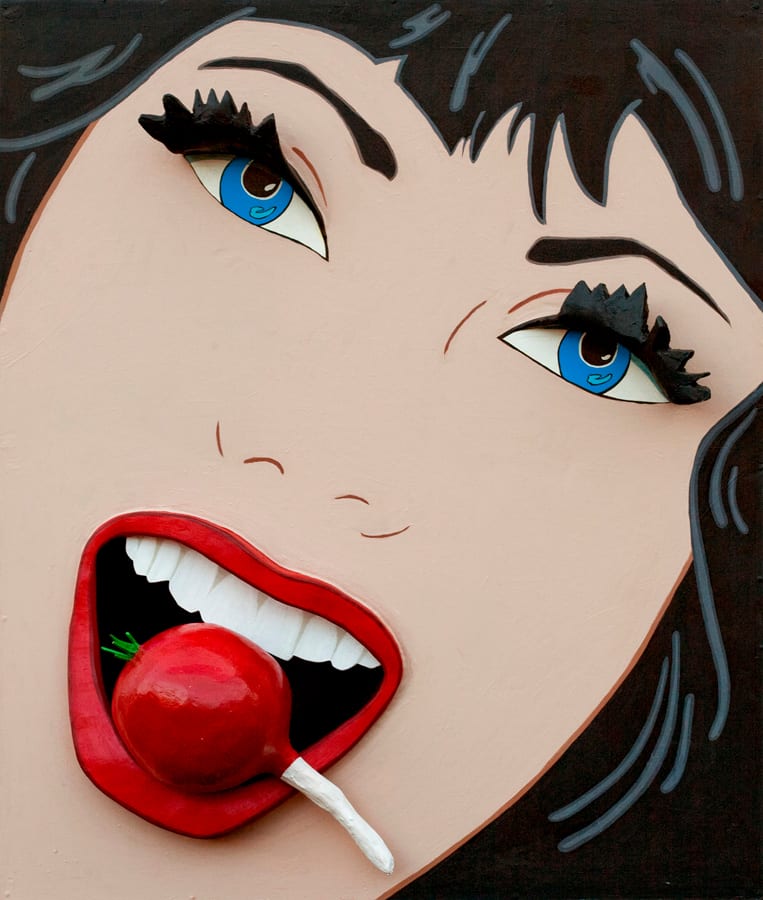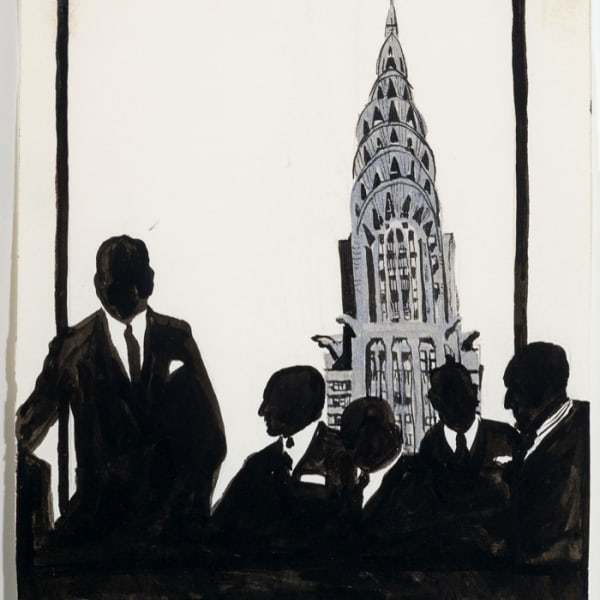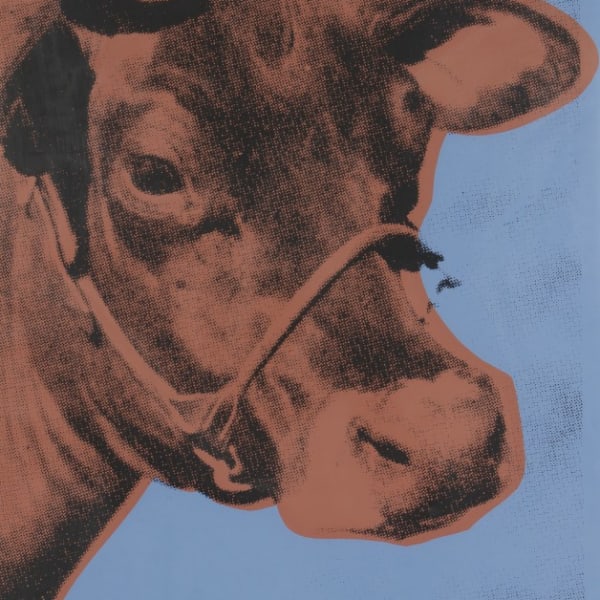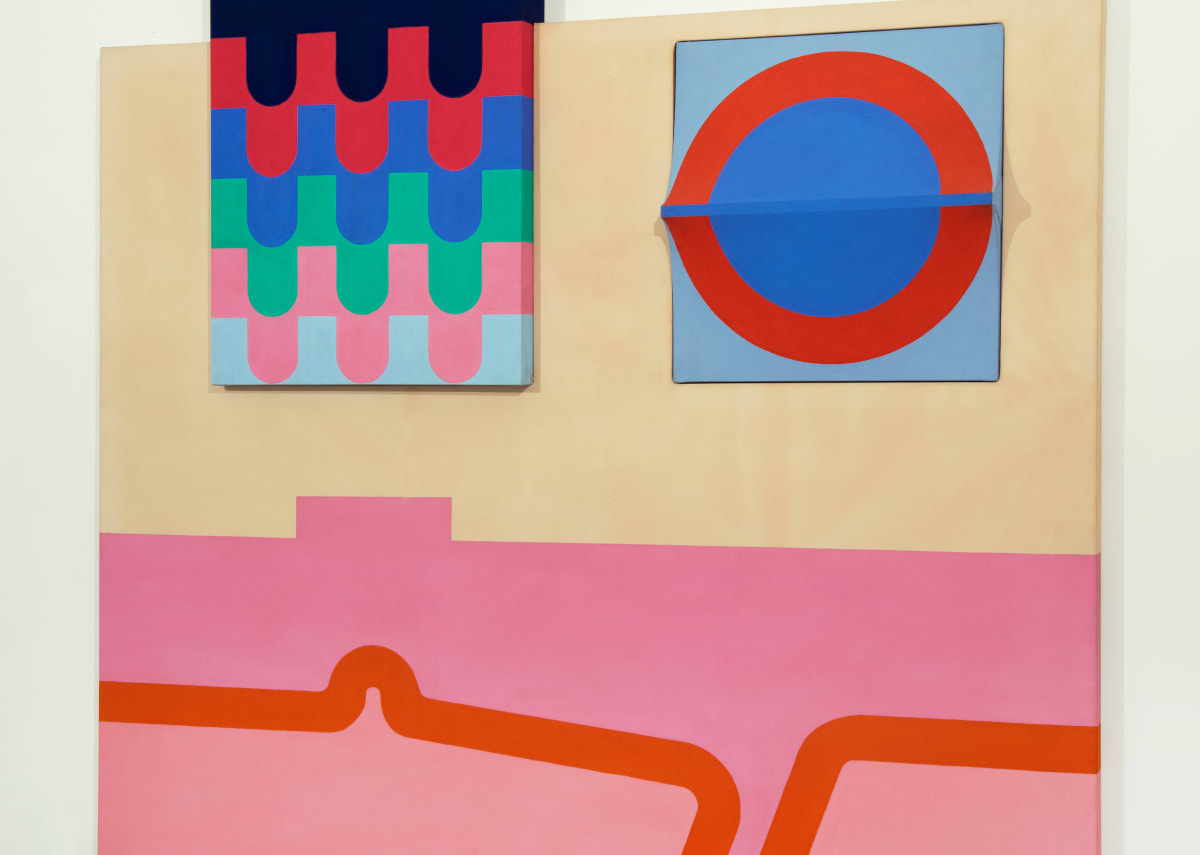
Strider’s work is a study in contradictions
In her fifty-year career, Marjorie Strider had relished in transgressing conventions and defying viewers’ expectations. Her still lifes are not still at all, but deliciously animated: radishes burst from the bunch, flowers bloom from their Masonite boards, and Coca-Cola fizzes a frothy, pink foam. Her paintings (and their titles) evoke the flat color panels and crisp outlines favored by her hard-edge and Minimalist contemporaries, yet they tackle the Pop artists’ everyday subject matter and tone. As paintings that hang on the wall, they are also sculptures that protrude from it, including carved wood and, later, foam projections. As a female artist among a movement dominated by men, she tackles an unlikely subject—the pin-up girl—that was synonymous with the objectification of women. In short, Strider’s work is a study in contradictions, and teasing out these contradictions generates the humor and pleasure we derive from it and marks its art historical importance.
In her fifty-year career, Marjorie Strider had relished in transgressing conventions and defying viewers’ expectations. Her still lifes are not still at all, but deliciously animated: radishes burst from the bunch, flowers bloom from their Masonite boards, and Coca-Cola fizzes a frothy, pink foam. Her paintings (and their titles) evoke the flat color panels and crisp outlines favored by her hard-edge and Minimalist contemporaries, yet they tackle the Pop artists’ everyday subject matter and tone. As paintings that hang on the wall, they are also sculptures that protrude from it, including carved wood and, later, foam projections. As a female artist among a movement dominated by men, she tackles an unlikely subject—the pin-up girl—that was synonymous with the objectification of women. In short, Strider’s work is a study in contradictions, and teasing out these contradictions generates the humor and pleasure we derive from it and marks its art historical importance.
Born in Guthrie, Oklahoma, Strider graduated from the Kansas City Art Institute and made her way to New York. The first exhibition she received was “The First International Girlie Show” at Pace Gallery, New York, in January 1964, which was inspired by her submission, Triptych.¹ The premise of the show was to demonstrate “the inspiration of girlie or pin-up as an American symbol,” and it recalled the popularity of burlesque entertainment, which had been on the decline since the 1930s. ² With the introduction of Hugh Hefner’s Playboy magazine in 1954 the pin-up, now rendered as the “centerfold,” increased in social acceptance and exposure. By the early 1960s, the subject fit perfectly with the other types of imagery adopted by Pop artists: brand-name products, consumer items, signs of quintessentially American modern life. Also “associated with the good life in America,” the all-American girl, and the male fantasies that gave rise to her, emerged as one aspect of the American dream.³
Strider’s women, more so than those by her male contemporaries, such as Roy Lichtenstein, Tom Wesselmann, Mel Ramos, Richard Lindner, and Allan D’Arcangelo, question “which is more real, the flat stereotype or its extension into 3-D, into the consumer’s space.”⁴ In Green Triptych, Strider’s bikinied beauty twirls for the viewer across three painted panels, proudly displaying her bulging bosom and bottom; she almost appears to wink at us with a knowing sense of her own objectification. Likewise, Girl with Radish seemingly bats her eyelashes, thickly encrusted with black paint mascara extending off the support, the radish playing a provocative role. In Come On, the green-eyed girl addresses us with a flirtatious come-on. This is the fantasy that these images project and simultaneously dispel.
Strider’s success in the “Girlie Show” secured her a solo exhibition at the Pace Gallery the following year, advertised as “Girls, Flowers, and Vegetables.”⁵ Her still lifes, in particular, bring to the fore-front her sophisticated exploration of the formal properties of representation. At a time when the boundaries between the mediums of painting and sculpture were increasingly amplified (most vocally by the critic Clement Greenberg), Strider’s works thoughtfully emphasize the “ambiguous zone where painting and sculpture overlap.”⁶ In Lilli Marlene (1962) and White on Green (1964), for example, she contrasts the flatness of her painterly style—achieved using acrylic paint and unmodulated areas of color—with the three-dimensionality of her resin reliefs, which she termed “build-outs.” One insightful reviewer of her 1965 solo exhibition remarked on the ways in which Strider’s paintings refused to conform to the traditions of the genre or medium: “It makes us a bit uneasy when these monstrous vegetables are no longer satisfied to be painted, when menacing sharp radishes and bulbous toma- toes start falling out of the painting.”⁷
The hybrid nature of her painted reliefs was integral to the success of Strider’s works. “Purely painted or mixed media pieces done on a flat plane couldn’t give me the feeling I wanted,” the artist explained in a 2003 interview. She emphasized, “I wanted rounder surfaces. More detail and more depth.”⁸ To create her “build-outs” the artist initially laminated and carved wood, relishing in how the “sheer physicality” of the process “flew in the face of gender-driven expectations.”⁹ She then moved to shaping plastic foam, which she covered with epoxy resin.
At the forefront of the use of these new materials, Strider adopted urethane foam, which takes shape when two chemicals are mixed. Concrete (1974) literalizes this concrete is poured and transformed into a painted green substance, ready to be used as a building material. Similarly, in Soda Box (1973) the painted baking soda carton, a product used to help batter rise, actually oozes plastic foam from its open top. The wit of the work also derives from the contrast between the adver-tised “pure and natural product” and its transformation into a blue toxic sludge. Yet this wit is not without bite. The foam suggests a “destruction of nature,” exemplified in many of Strider’s works from the 1970s, where foam seeps through and pushes past Venetian blinds, explodes from fragile pack- ages, and thwarts the attempts of brooms to sweep it away.
Strider’s interest in the formal properties of urethane foam inspired her series of site-specific installations, in which the “ooze” tumbles down stairs, overtakes building facades, and descends from windows. These works contrast with the very masculine precedents set by Jackson Pollock’s explosive action painting drips and Robert Smithson’s “pours,” in which he, in different earthworks, spilled glue, concrete, and asphalt in an exploration of the principles of entropy and chaos. Strider’s candy-colored oozes have taken shape at Vassar College, PS1 in Long Island City, the Neuberger Museum in Purchase, New York, and the Kunsthalle in Hamburg, among other galleries and museums.
process—More recently Strider had returned to the subject matter that launched her career in the 1960s. In paintings such as Descending, Strider’s subject evokes well-known art historical precedents, from Marcel Duchamp’s 1912 masterpiece to Gerhard Richter’s 1966 Ema (Nude on a Staircase). In Big Bite, from 2010, she simplifies and crops the composition of an earlier work such as Girl with Radish, rendering the now disembodied open mouth, poised to chomp on a radish, as even more absurd and threatening. These paintings also demonstrate the artist’s continuing interest in the relationship of color and form, and show how she accomplishes these formal investigations with great drollness, intelligence, and vivacity. Her works “pop,” often quite literally in extending from their supports, but also metaphorically, in the way in which they burst our long-held and improbable bubbles (who hasn’t dreamed of being or being with a sun-tanned, buxom beauty, only to realize that only happens in the movies?) In this Strider’s art evinces the characteristic Pop approach, both celebrating and critiquing aspects of modern American life by drawing on a slick, deadpan style associated with advertising. Yet she also moves beyond it, in exploring the very ways in which those subjects are represented, in two and three dimensions, taking up questions at the essence of modernism.
—Kirsten Olds, Associate Professor of Art History, University of Tulsa
Notes
1. Interview with John Gams in Marjorie Strider: Dramatic Gestures (Lenox, Mass.: Hard Press Editions, 2004), 98.
2. An advance exhibition notice quoted by John Canaday, “Art: From Clean Fun to Plain Smut,” New York Times,
January 7, 1964, L31.
3. Sidra Stich, Made in U.S.A.: An Americanization in Modern Art, the ’50s and ’60s (Berkeley, Calif.: Berkeley Art
Museum, 1987), 31.
4. Review of Strider’s 1965 exhibition at Pace Gallery, New York, otherwise unidentified clipping, Hollis Taggart Galleries.
5. Reviewers of the exhibition note that only one “girl” was on display.
6. Raphael Rubinstein, preface to Marjorie Strider: Dramatic Gestures, 10.
7. Review of Strider’s 1965 exhibition at Pace Gallery, New York, article clipping.
8. Interview with John Gams, 99.
9. Ibid.
























